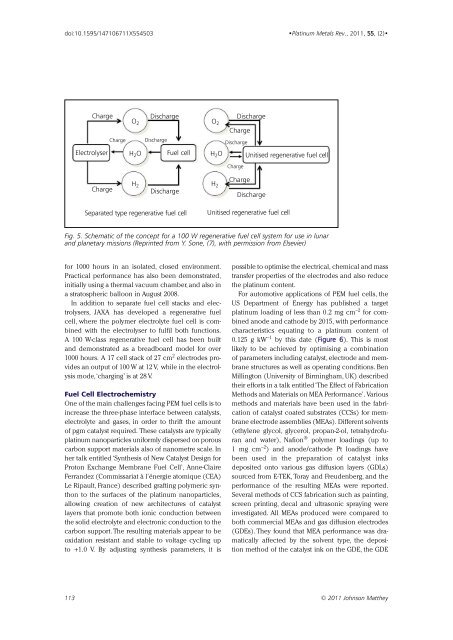Download - Platinum Metals Review
Download - Platinum Metals Review
Download - Platinum Metals Review
Create successful ePaper yourself
Turn your PDF publications into a flip-book with our unique Google optimized e-Paper software.
doi:10.1595/147106711X554503<br />
•<strong>Platinum</strong> <strong>Metals</strong> Rev., 2011, 55, (2)•<br />
Charge<br />
O 2<br />
Discharge<br />
O 2<br />
Discharge<br />
Charge<br />
Charge Discharge<br />
Discharge<br />
Electrolyser H 2 O Fuel cell H 2 O Unitised regenerative fuel cell<br />
Charge<br />
Charge<br />
H 2 H 2<br />
Discharge<br />
Charge<br />
Discharge<br />
Separated type regenerative fuel cell<br />
Unitised regenerative fuel cell<br />
Fig. 5. Schematic of the concept for a 100 W regenerative fuel cell system for use in lunar<br />
and planetary missions (Reprinted from Y. Sone, (7), with permission from Elsevier)<br />
for 1000 hours in an isolated, closed environment.<br />
Practical performance has also been demonstrated,<br />
initially using a thermal vacuum chamber, and also in<br />
a stratospheric balloon in August 2008.<br />
In addition to separate fuel cell stacks and electrolysers,<br />
JAXA has developed a regenerative fuel<br />
cell, where the polymer electrolyte fuel cell is combined<br />
with the electrolyser to fulfil both functions.<br />
A 100 W-class regenerative fuel cell has been built<br />
and demonstrated as a breadboard model for over<br />
1000 hours. A 17 cell stack of 27 cm 2 electrodes provides<br />
an output of 100 W at 12 V, while in the electrolysis<br />
mode,‘charging’ is at 28 V.<br />
Fuel Cell Electrochemistry<br />
One of the main challenges facing PEM fuel cells is to<br />
increase the three-phase interface between catalysts,<br />
electrolyte and gases, in order to thrift the amount<br />
of pgm catalyst required. These catalysts are typically<br />
platinum nanoparticles uniformly dispersed on porous<br />
carbon support materials also of nanometre scale. In<br />
her talk entitled ‘Synthesis of New Catalyst Design for<br />
Proton Exchange Membrane Fuel Cell’, Anne-Claire<br />
Ferrandez (Commissariat à l’énergie atomique (CEA)<br />
Le Ripault, France) described grafting polymeric synthon<br />
to the surfaces of the platinum nanoparticles,<br />
allowing creation of new architectures of catalyst<br />
layers that promote both ionic conduction between<br />
the solid electrolyte and electronic conduction to the<br />
carbon support. The resulting materials appear to be<br />
oxidation resistant and stable to voltage cycling up<br />
to +1.0 V. By adjusting synthesis parameters, it is<br />
possible to optimise the electrical, chemical and mass<br />
transfer properties of the electrodes and also reduce<br />
the platinum content.<br />
For automotive applications of PEM fuel cells, the<br />
US Department of Energy has published a target<br />
platinum loading of less than 0.2 mg cm −2 for combined<br />
anode and cathode by 2015, with performance<br />
characteristics equating to a platinum content of<br />
0.125 g kW −1 by this date (Figure 6). This is most<br />
likely to be achieved by optimising a combination<br />
of parameters including catalyst, electrode and membrane<br />
structures as well as operating conditions. Ben<br />
Millington (University of Birmingham, UK) described<br />
their efforts in a talk entitled ‘The Effect of Fabrication<br />
Methods and Materials on MEA Performance’. Various<br />
methods and materials have been used in the fabrication<br />
of catalyst coated substrates (CCSs) for membrane<br />
electrode assemblies (MEAs). Different solvents<br />
(ethylene glycol, glycerol, propan-2-ol, tetrahydrofuran<br />
and water), Nafion ® polymer loadings (up to<br />
1 mg cm −2 ) and anode/cathode Pt loadings have<br />
been used in the preparation of catalyst inks<br />
deposited onto various gas diffusion layers (GDLs)<br />
sourced from E-TEK, Toray and Freudenberg, and the<br />
performance of the resulting MEAs were reported.<br />
Several methods of CCS fabrication such as painting,<br />
screen printing, decal and ultrasonic spraying were<br />
investigated. All MEAs produced were compared to<br />
both commercial MEAs and gas diffusion electrodes<br />
(GDEs). They found that MEA performance was dramatically<br />
affected by the solvent type, the deposition<br />
method of the catalyst ink on the GDE, the GDE<br />
113 © 2011 Johnson Matthey
















